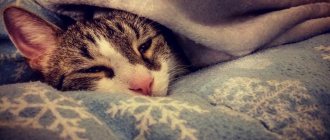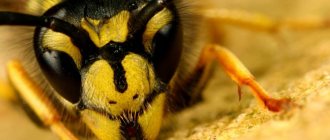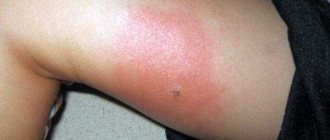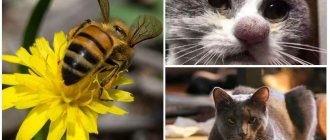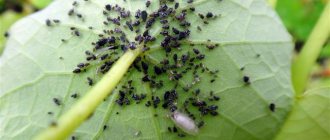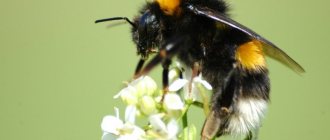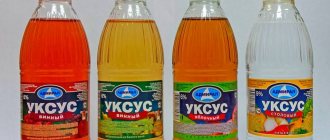What to do if a dog is bitten by a wasp, you should not panic, but you need to provide first aid to the pet and observe its behavior for an hour. In most cases, a wasp attack is not life threatening to the dog, but it is a potential possibility. The complexity of the symptoms depends on the age of the animal, the location of the bite, and the individual characteristics of the body. The main role is played by the response of the immune system, which is always activated after wasp venom enters the bloodstream and damages the skin.
Signs of a bite
The dog owner may miss the moment of the insect attack, so it is important to determine who bit - a wasp or a bee. The latter leave a sting that continues to pulsate, releasing an ever-increasing amount of poison into the blood. The wasp is capable of biting several times in one attack, but never leaves the sting.
In addition to external symptoms on the skin, the animal’s behavior changes, and a deterioration in well-being may be observed. If a puppy has been bitten by a wasp, he will squeak, whine pitifully, and ask for help with teary eyes. If a wasp stings the face, severe noticeable swelling will follow.
Important!
The most dangerous situation is when the insect managed to get caught in the tongue. In this case, it swells, increasing the likelihood of air blockage and swelling of the larynx.
Normal reaction to a wasp sting
Venom enters the bloodstream and is injected by the insect after the sting penetrates the skin. Pain is immediately felt at the puncture site, followed by an immediate local reaction:
- redness;
- swelling;
- edema;
- in the center of the blister there is a dark dot of dried blood.
Wasp bites on a dog
After a wasp attack, the behavior of the dog or puppy changes. The first sign that something is wrong is whining. They whine pitifully, tears roll into their eyes. The pet tries to bite and lick the sore spot.
The discomfort disappears during the day, the next day itching appears, which causes the animal to scratch. There is a certain danger in this, since a secondary infection can get into the wounds. To avoid negative consequences, a wasp sting must be treated with an antiseptic, this should be done for 2-3 days until the wound begins to disappear. The skin is finally restored within a week. A photo of a wasp sting on a dog with a normal reaction is shown below.
Stinging insects dangerous to dogs
It’s not entirely correct to say “bitten by a bee,” because bees sting. The same applies to bumblebees, hornets, and wasps, although wasps can bite, using the jaw apparatus for defense. It is important to determine which insect stung the dog; first aid for the pet, aimed at neutralizing the poison, depends on this.
To determine which insect stung the dog, you need to examine the site of the bite. Bees use their sting only once. The bee sting has a bag of poison and barbs, so it remains in the wound, and the bee soon dies.
Worker bumblebees and the queen have a sting, but it is not serrated and insects can use it many times.
Wasps are dangerous because they can sting repeatedly without harm to themselves, and they can use their jaws to protect themselves. Wasp stings are more painful compared to bees.
Large hornets have a smooth sting, so the hornets can use it repeatedly. Compared to other common stinging insects, hornets are more dangerous because they can gnaw through fruits and vegetables while remaining inside. There is a risk of swallowing them along with a bitten piece of fruit.
The danger of bees and other stinging insects for dogs is that the insects react to the smell of poison and fly to the aid of the individual who has begun the attack on the dog. Considering that one individual can attack several times, a group of insects can cause serious harm to the animal.
Allergic reaction
Signs of allergies can be external or systemic. Appear within 5-20 minutes. A large swelling, swelling, large-scale edema appears on the skin, the diameter of the red spot is more than 1 cm. Additionally, a rash and severe itching are observed. But the most dangerous signs of allergies are systemic. There is a change in the pet's behavior and condition.
- lacrimation;
- increased salivation;
- vomit;
- diarrhea;
- loss of appetite;
- refusal of food;
- drowsiness, apathy or irritability, aggressiveness;
- disturbing sleep;
- convulsions;
- holding your breath;
- violation of movement coordination.
Consequences of a wasp sting for a dog
The worst consequence of an allergic reaction is anaphylactic shock. It is extremely rare, but the potential for its occurrence is always there.
On a note!
If a dog swallows a wasp, there is nothing wrong with it, provided that the insect did not have time to bite. Being in the esophagus, stomach, the likelihood of a bite is reduced. If a dog has eaten a wasp and begins to whine pitifully, you should immediately administer antihistamines yourself or take the animal to the vet if the pet refuses to swallow the tablet.
When to contact a veterinarian
You should definitely contact your veterinarian if:
- A wasp has bitten a puppy or small animal.
- The bites occurred on the head and neck area. Damage to these areas can cause severe swelling and suffocation.
- When bitten in the abdominal area. Getting such a lesion can cause problems with urination.
- With numerous bites.
- Insect damage to the animal's eyes.
You should immediately show the animal to a specialist if the manifestations of an allergic reaction listed above are observed.
First aid
What to do if bitten by a wasp - provide emergency assistance.
- Inspect the wound for the presence of a sting. If it is present, you need to carefully remove it with tweezers. Further actions are identical for a wasp or bee sting.
- Rinse the wound under running water to remove any remaining poison. If this is not possible, disinfect it. Pharmacy and folk remedies can be used as an antiseptic, depending on the conditions under which the bite was discovered.
- Apply ice cubes and a cold compress to the sore spot. This will help relieve swelling.
Treatment of a wasp bite on a dog
Further actions depend on the complexity of the symptoms - you can wipe the wound with decoctions of medicinal herbs, fruit juice, vegetables, apply ointments, soothing, anti-inflammatory cream, anti-allergic drugs. If a wasp has bitten you in the face or the puppy has been injured, you need to give an antihistamine orally in the form of a tablet or drops. This will prevent and stop an allergic reaction.
Allergy
While walking, your dog was stung by a bee or wasp, developed an allergic reaction, and you don’t know what to do? It is urgent to administer an antihistamine. This may be chloropyramine or tavegil. Diphenhydramine shows good results, but pharmacies sell it with a doctor's prescription. Medicines are administered by injection. The dose is selected depending on the size of the bitten dog (its weight).
- up to 10 kg - 0.1 ml/kg;
- from 10 to 20 kg - 1 ml;
- more than 20 kg - 2 ml.
What should you do if your dog is bitten by a wasp on the cheek or lip and severe swelling develops ? A glucocorticosteroid drug, dexamethasone, . It is an immunosuppressive, anti-inflammatory drug. Used for anaphylactic shock, edema, acute manifestations of allergies. The dosage of the medicine is selected taking into account the size of the dog according to the formulas specified in the instructions.
Folk remedies
If your dog has been bitten by bees or wasps, you need to try to eliminate the unpleasant painful symptoms and prevent infection. Otherwise, it will begin to fester, become swollen, and ulcers will appear. This situation requires the use of local antibiotics and consultation with a veterinarian.
At home, treat the dog with the following means:
- ammonia, medical;
- alcohol tincture of medicinal herbs - valerian, glod, motherwort, calendula are suitable;
- juice of lemon, cucumber, parsley, onion;
- quality vodka;
- citrus;
- vinegar solution - 200 ml of water, 1 teaspoon of table vinegar;
- baking soda paste - moisten with water, stir, apply to the affected area until dry;
- toothpaste;
- shaving foam;
- ice, cold water, a bottle of cool drink, frozen meat;
- decoction of chamomile, mint, lemon balm;
- aloe juice
Folk remedies for wasp bites
On a note!
In field conditions, the bite is treated with the juice of plantain, celandine, dandelion, and washed with water. Upon returning home, they provide qualified assistance.
A dog was bitten by a wasp or a bee: what to do next?
If a puppy is stung by a bee
, he will definitely start to behave restlessly. As a rule, the affected area hurts and itches for several days. To prevent the dog from scratching the wasp bite into a deep wound and introducing infection into the blood, it must be treated. This can be done using any anti-allergy ointment, for example:
- Lorinden;
- Sinaflana;
- Fenistila;
- 1% hydrocortisone ointment.
For prevention, it is advisable to give the dog an anti-allergy tablet. It could be:
- Tavegil, Suprastin or Diphenhydramine;
- Dexamethasone or Furosemide.
The proportions are as follows:
Pharmacy drugs
If a wasp bites a dog on the paw, there is no particular danger. It is enough to disinfect the wound, apply an antihistamine, sedative - cream, ointment, gel. If a wasp bites you and an allergic reaction occurs, you need to use special antiallergic ointments. It is better to consult a specialist for advice.
Important!
The duration of therapy with hormonal drugs should not exceed 3 days.
They use products used to treat people in case of insect attack.
- Fenistil. To treat the skin, a gel is used that has antihistamine, antipruritic, anti-inflammatory, and healing properties. Drops with the same name are given internally.
- Balm Star. Safe product for puppies and dogs of all breeds. Acts on the basis of extracts of medicinal plants and oils. Processing is allowed every 2 hours.
- Advantan. The antiallergic agent quickly eliminates the symptoms of irritation and stops the pathological process. Apply only 1 time per day.
To speed up the healing of a dog's wound, use a regular moisturizer.
Further treatment
When antiallergic and anti-inflammatory drugs are administered, no further treatment is required. If the swelling does not subside, you can use diuretics such as Indapamide and Furosemide. If necessary, antiallergic drugs can be reused (the frequency of drug administration may vary and should be indicated in the instructions). However, it is not recommended to use them for more than 3 days.
At the site of the bite, especially when using ointments and disinfectants, the skin often becomes dry. Because of this, wound healing may slow down. In addition, increased dry skin increases itching. To normalize the condition of the skin, you can use moisturizing ointments.
Photos of animals bitten by wasps
The body's reaction to an insect attack can manifest itself in different ways. Yard dogs can more easily tolerate poison entering the bloodstream and a painful attack; purebred dogs often require special treatment. The most pronounced reaction in all breeds is if a wasp bites your nose. It swells, turns red, swells, and changes the appearance of the pet. Below is proof of this. York was stung by a wasp.
Animals bitten by wasps
Reacts painfully to Chihuahua bites. View of a dog after an insect attack below.
The toy terrier tolerates a wasp attack more calmly; severe allergies rarely occur, but the individual characteristics of the pet must be taken into account.
No matter what breed the dog is, you need to promptly respond to the dog’s whining, blisters on the skin, and provide first aid. Insects begin to sting in the spring, so you should always have antihistamines available and carry them with you when walking in nature with your dog.
Prevention of attacks
When walking with your animal, you need to ensure its safety. To do this, do not allow your pet near dense bushes with flowering plants and berries. It is in such places that wasps are most often found. Particular attention should be paid to active breeds, as such dogs show more interest in their surroundings.
Advice! It is best to check the walking area for insects. By following these rules, the owner of the animal will be able to protect his pet from a sudden attack.
By following safety rules and having a veterinary first aid kit with you, you can protect your pet from unforeseen situations. You should be vigilant and closely monitor the animal that is in the territory of flowering plants.


